#roman stonecarving
Text


Two Romano-Celtic Deity Carvings, 1st to 2nd Century CE, The National Museum of Scotland, Edinburgh.
#roman#Romano-Celtic#local deity#roman deity#roman belief#ancient beliefs#ancient living#ancient craft#archaeology#relic#artefact#Scotland#roman army#roman empire#stonework#roman stonecarving#stonecarving#early religion#symbols
49 notes
·
View notes
Photo

It's been a minute since I posted anything and I can feel the itch to share again. Most of January, for me, has been dominated by freelance content and design work. But I am still making lots of progress on next month's shop update. And while I'm not ready to set a date yet, I wanted to share some of the inspiration behind Myths & Legends. I've always been utterly fascinated by the stories in myths, legends, fairy tales, fables, and anything other-worldly that was once regarded as having a foot in the real world. When I travel, I'm looking for ruins, monuments, relics, and pieces of ancient civilizations. Not because I want to uncover and piece together what used to be, but because I want to use that energy to spark my creativity. I find it positively electric to set foot on ground that has seen many thousands of years worth of human stories. For example, I took this photo of a carving at Rosslyn Chapel in 2003. I'd traveled to Scotland to visit my father's family and it was an amazing trip on many levels. I went back to the UK in 2009 and during that trip visited Chester, specifically the ruins of Roman infrastructure and of St. John's Church. I promised myself I'd use the latter to inspire a setting for my next book. And I kept that promise when I wrote The Variant Conspiracy trilogy. This month, on my metalsmithing side, I'm diving back into mythology, more broadly this time and it's been a huge amount of fun. Because I can't get enough of stories that help us explore who we used to be, what we used to believe, how we collectively saw the world and understood the nature of life, the universe, and everything. I have a lot of work left before I can set the date for Myths & Legends. But it has been addictive immersing myself in the imagery of those worlds, so it won't be much longer, I promise.🤞 #rosslynchapel #stonecarving #romanruins #stjohnschurch #ukruins (at UK) https://www.instagram.com/p/CnpuIesyOxc/?igshid=NGJjMDIxMWI=
0 notes
Photo
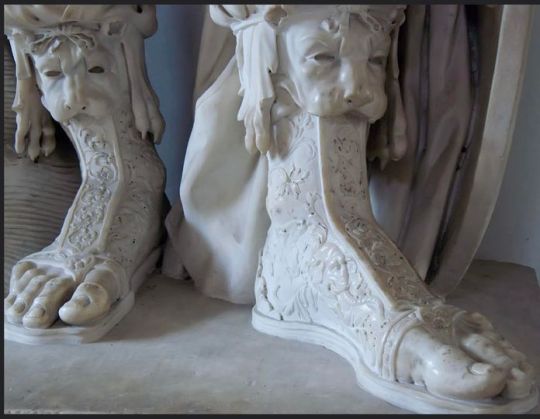
A detail of the boots of Mars, carved in very fine stone and will a level of detail that’s simply amazing.
This level of craftsmanship simply boggles my mind.
#europa#marble#craftsmanship#blacksmithing#stonecarving#tradition#culture#Mars#greekmythology#roman mythology#history
82 notes
·
View notes
Text
A rambling musing on mortgages, stone lions, traffic signs, & European heraldry, the symbology that rules much of our modern lives.
Stone Lions at the end of a driveway...means that the mortgage has been paid off.
I like this concept...except I think I’d want to get stone snow leopards. I grok them (get them / intuitively understand them / feel at one with them) more than lions, or any other cat...other than housecats. Might be easier to get stone housecats...but if I got them...
Would I get them as Sejant (heraldic term for cats sitting upright, butt on the ground, forelegs vertically straight, think cat statues from Egypt), Couchant (heraldic term for butt & belly/chest on the ground, forelegs semi-stretched in front, head erect, think of lions in front of the NYC Public LIbrary), Dormant (same as couchant but head down, napping), or Catloaf (not an official heraldic position/term, but basically couchant with the paws tucked under, head erect)...?
Rampant (heraldic for one foot on the ground, the other three raised as if scratching/mauling/attacking) would be difficult to acquire, and require either: hellaciously expensive stonecarving with supportive flora or flowing cloak or tail dragging on the ground, etc, to hold up the weight of the body; cement or geopolymer with steel rebar support welding it to a heavy base; wrought iron (which can support its own weight on one slender-by-comparison hind leg); or cast resin...which would require more supportive elements.
Or maybe I could go totally modern and install video screens, and just stream images of funny cat gifts & videos all the time...? (And occasionally flash a sign, “This is NOT a drive thru entrance, No U Cannot Haz Cheezborgers Here!”...?)
...Also I have no idea what to call this position, heraldically. (Which could totally be my aesthetic, not gonna lie...well not gonna fabricate, ‘cause obviously if it’s my aesthetic, it’s my position and I’ll lie down ‘n mlem it, lol.)

If it were a bird, it would be Splayed, but splayed is seen in a position looking directly at the belly of the beast, like an X shape, usually with the head at the top of the image, tail (feathered or otherwise) down at the bottom. This is like...dormant inverted?
The tongue mlemming in the .gif would not be replicatable in a static image, but tongues showing is often a part of heraldic design; you just have to say “langued (color)” (langued = we gave it a tongue, yo!) to indicate it’s visible.
And since snow leopards are automatically argent (white/silver, a metal (the other metal is Or, gold/yellow, and always written with a capital O)) spotted sable (black, a color, but in minor amounts compared to the main color)...you have to tint the langue (tongue) a contrasting hue.
This means that argent (the main ‘color’ of the beast, heraldically considered a metal) must be langued (given a tongue) with a color (often rouge (red) or azure (blue), but could also be purpur (purple) or even vert (green)). Or it could be tinted with a “fur” (spotted in special ways, or patterned in specific ways meant to emulate ermine spots, grey squirrel fur backs & bellies, etc, but let’s be honest, a tongue is too small for that, and my tongue isn’t always dead-fuzzy in the mornings, so it’s not 100% “me” to have a furry tongue.)
Confusing? I know!
But remember, European heraldry was designed to Make Things Visibly Distinct At A Distance. Before the eras of snazzy uniforms (American Revolution, French Revolution & Napoleonic Wars, the Prussian Army, etc, etc), everybody just threw on whatever armor or protection they had available and went to war...and...in the melee scrum, everyone moshpitting around you could easily end up killing folks on your own side by pure mistake.
So heralds came up with rules for heraldry...and to this day, those rules govern our lives, writers, artists, readers...and those rules have gone worldwide. Not just because of colonialism (sorry for that part of things, everyone else), but because the rules work.
If I recall correctly, I’ve blazoned (written out in fancy heraldry language) this particular sign before:

On a lozenge Or within an orle, on a billet sable, a torteaux, a bezant, and a pomm. --12th Century Norman Heraldry language (English translation: With our fancy shorthand language and its many governing rules, we are describing a yellow diamond shape with a thin black border around its edges that doesn’t actually go all the way to the edges, so you still see a little bit of yellow at the very edges of the sign; in the center of all that yellow is a black rectangle that’s vertically long, and on that black rectangle we can see a red circle at the top, a yellow circle in the middle, and a green circle at the bottom.)
Aka it’s a Traffic Sign Ahead sign. For those who aren’t visually impaired, if you’re on the internet, you’ve probably been exposed to enough other modern life images to know what this is.
The yellow background is bright but light in color, compared to the black, the red, and the green elements. (Btw, a torteaux is French for cake, bezant means the gold coin of the Byzantine Empire, and a pomme is French for green apple; it’s way shorter and more concise to say a torteaux, which is automatically defined as red & round, than a red circle, one word for the price of two.)
Here’s another one, a little more challenging to define:

Ignoring the 3D-esque shadowing and oulining, we have:
Argent within an orle sable, a fletchless arrow upright, shaft and pheon broken to dexter, sable, surtout an annulet barred bendwise gules.
...Who the what now??
Since it’s not on a diamond shape (lozenge), but instead on a square (a form of rectangle), we don’t have to mention the shape, this time. Coats-of-arms are always presumed to either go on a shield shape or a flag (rectangle or square) shape. It’s only when you get fancy (or female coats-of-arms, blah blah blah), that you have to mention it being on any other shape.
Argent (white background) within an orle sable (thin black border that doesn’t actually touch the edges, same as above), a fletchless (no feather bits) upright (arrow pointing up), Shaft and pheon (midpoint and arrowhead) broken dexter (to the viewer’s left, but the wearer’s right if they’re actually wearing this as a shield or a tabard; the fact that we include the pheon (arrowhead) in this indicates the arrowhead is off to the viewer’s left); surtout (another object lying on top of the last one(s) we just described) an annulet (fancy name for ring) barred (it’s got a stripe across it!) bendwise (hey, it’s a diagonal stripe, from dexter chief to sinister base (viewer’s top left to bottom right, but the wearer’s top right to bottom left), gules (ande hey, it’s red!!).
Basically it’s a No Left Turns Allowed sign. The red circle-with-diagonal-slash is a “Not Allowed” symbol, and the arrow points to the viewer’s left, indicating “Do Not Turn Left Here.”
Black on traffic signs is a strong color that shows up very well against yellow (the color used for cautionary rules, curvy road ahead, rocks falling, pedestrian crossing, etc) and white (absolute rules, such as Speed Limit/Maximum signs and Do Not Enter signs, etc.). Black is most often used for either text, or for arrows and other lines indicating the flow of traffic (merging lanes, etc).
It’s visually friendly to pair up a very strong color (black, red, brown, blue, green, rarely purple) with a pale one (white or yellow). People who have colorblindness issues or who need glasses to see can usually still tell the various bits apart with these high contrast choices.
But...the smaller the details, the less you want to clutter those details. So the basic rule in heraldic design is, make the image about 6 inches tall, pin it to a wall, and stand back 10, 15, or even 20 feet. Can you still tell what it is? Yes? Good design! If you cannot...rework it!
So...the reason why I got off on this tangent is that...well...I finally sold my house. Which means my mortgage is technically paid off.
So I could get stone lions for my driveway...except I no longer own the property. *sigh*
But I’m hoping to take the funds leftover from paying off the mortgage to buy land outright, and build a tiny house on it. Which hopefully would be paid off without needing a mortgage...or maybe only the tiniest of mortgages...which means I could get “stone lions” for my driveway, some day.
...Which don’t have to remain stone-colored.
See, that’s the thing: statues in medieval times weren’t always plain stone, ya know! (Certainly not in Roman & Grecian days, hoo boy did they love color!) They painted them, covered them in fabric and flowers, applied gold and silver leaf, copper sheathing, etc, etc, etc.
So I’m sitting here wondering what sort of “My House & Land Are All Paid Off” stuff I could get. Because I (technically) could...some day.
15 notes
·
View notes
Photo

**Sculpture Update** I’ve moved into my new studio. I now need to build a couple of banker/carving tables and replace some tools. A massive thank you to my buyers/patrons so far, ☺️🙏 I’m now opening up three more pre-sale offers to raise some much needed cash to buy tools, materials and print room hire. (Details below) ⬇️⬇️⬇️ A massive thank you again to @nordiamarble and the yard manager. Pentelic marble is A1 grade stone and these blocks are A1 cuts from that. #PentelicMarble is quarried 12 miles north west of #Athens and it’s loaded with history 💚➡️ https://en.m.wikipedia.org/wiki/Mount_Pentelicus ⬅️👀 Apparently it’s so good the Romans exported it to Rome for some of their best buildings and sculptures. The #Acropolis, #Parthenon and #ParthenonMarbles are also made from this stone 💚➡️ https://en.m.wikipedia.org/wiki/Acropolis_of_Athens ⬅️👀 💚➡️ https://en.m.wikipedia.org/wiki/Elgin_Marbles ⬅️👀 I’m creating a new body of work working on small blocks, a series of 20 pieces, 30x15x15cms and carving the same forms I did in the UK from limestone (pictures on my Instagram), also a series of paintings, screen prints and collagraph prints. but to help me further subsidise this project, I’m going to offer up to 3 sculptures for a £250 deposit then £500 final payment + shipping when finished. As I have a few galleries interested in my work here in Athens, the retail price for individual pieces this size, going through them when the project is complete, will be £3,000 each. This is going to be a one year project, making the artworks with the intention of exhibiting them in a show here in Athens, with a catalogue, that will give all the finished pieces a good provenance. #Sculptor #SculptorsOfInstagram #Pentelic #Marble #StoneCarving #Carving #Artist #Kerameikos #Metaxourgeio #Athens #Greece (at Μεταξουργείο) https://www.instagram.com/p/CaMvN4WsGm_/?utm_medium=tumblr
#pentelicmarble#athens#acropolis#parthenon#parthenonmarbles#sculptor#sculptorsofinstagram#pentelic#marble#stonecarving#carving#artist#kerameikos#metaxourgeio#greece
0 notes
Photo

#Stockholm #Sweden #Svenska #stonecarving #capitals #roman #gold #foundtype #street #type #streettype #streettypography #typespotting #letterspotting #typography #letters #lettering #design #graphicdesign #dailytype #inspiration #sign #signage — by Urtd (Also on Instagram and Flickr)
0 notes
Photo

Stone with some script carved on it (maybe a tombstone) in the ancient city of Hierapolis. The city is built on top of the amazing travertine terraces of Pamukkale (Cotton Castle), located in Turkey's Inner Aegean region, in the River Menderes valley. 2007 #hierapolis #pamukkale #denizli #turkey #türkiye #turkiye #cottoncastle #clouds #cloudy #cloud #outdoor #stone #carving #stonecarving #carved #carvedstone #script #roman #greek #anatolia #ancient #photography #photographer #yellow #blue #ruin #ruins #tomb #tombstone #guneyozsan (at Hierapolis, Pamukkale)
#cottoncastle#denizli#outdoor#stonecarving#yellow#carved#carving#cloud#turkey#anatolia#ancient#script#photographer#ruin#carvedstone#pamukkale#hierapolis#blue#photography#turkiye#stone#clouds#türkiye#cloudy#greek#roman#tombstone#guneyozsan#tomb#ruins
0 notes
Text


Roman Sandstone Head from Winterslow, 1st to 4th Century CE, possibly depicting a local native god, The Salisbury Museum, Wiltshire
#roman#roman style#romans#roman belief#roman arts#roman empire#roman craft#roman living#roman culture#roman statue#roman figure#figurehead#roman stonecarving#stonecarving#ancient culture#ancient craft#ancient living#archaeology#Salisbury Museum
65 notes
·
View notes
Text
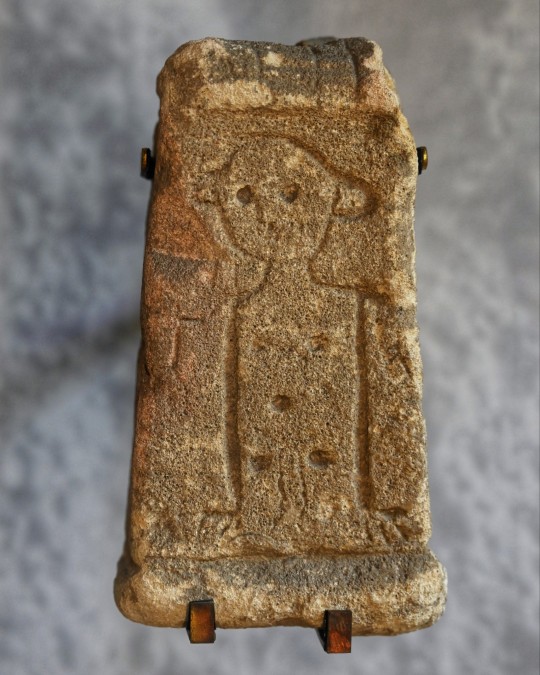
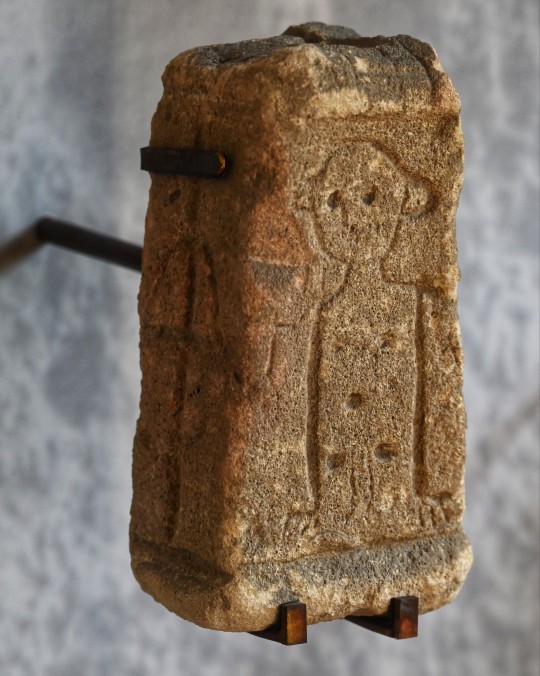
Roman Portable Shrine, Chedworth Roman Villa, Gloucestershire
One of several small altars believed to be deliberately portable, and so able to travel with individuals or families, The god is believed to represent Mars Lenus, a deity who was a Roman and Celtic amalgamation. The recessed dots would have been filled with colour, marking out the eyes, nipples, navel and genitalia.
#roman#romans#roman belief#roman living#roman army#roman design#roman archaeology#roman culture#stonework#stonecarving#celtic gods#celt#celtic#archaeology#Chedworth Roman Villa#Gloucestershire#relic#artefact
1K notes
·
View notes
Text

Small Stone Altar With Carved Figure, Chedworth Roman Villa, Gloucestershire
One of the three altars found at Chedworth Roman Villa believed to be dedicated to Mars Lenus. Mars was the Roman god of war and Lenus a native war god from Germany. The figure carries a spear and axe, and above is the faint dedication, "L M for Leno Marti or Mars Lenus.
#roman#romans#roman villa#roman empire#roman britain#roman belief#gods#celtic gods#celt#Romano-Celtic#ancient living#ancient craft#ancient culture#stonework#archaeology#relic#ritual#stonecarving#deity#roman religion#mars#lenus
79 notes
·
View notes
Text
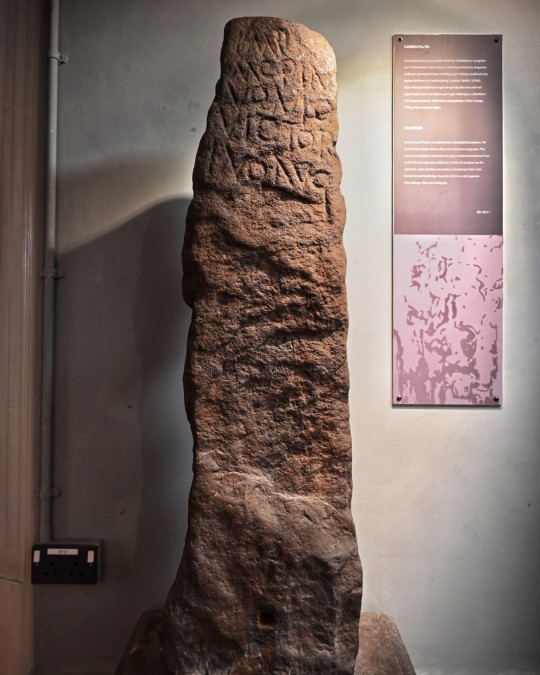
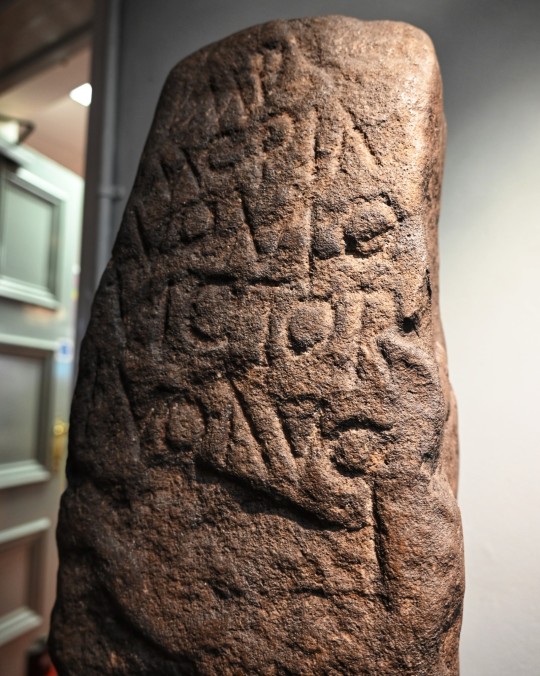

Roman Milestone, Swansea Museum, Wales
A rectangular Roman inscribed stone; translated inscription: 'for the Emperor Caeser Marcus Piavonius Victorinus Augustus'. This stone was probably erected by the legion stationed at Bovium Fort on the Roman road. Date 268AD to 270AD. It's location lost for centuries, some scholars now believe that Bovium Fort is the Roman fort at Cowbridge. Found in 1835 in a wall opposite Pyle Cottage, Pyle, near Bridgend.
#roman#romans#roman milestone#milestone#roman army#roman craft#roman empire#roman living#roman soldiers#roman road#roman building#archaeology#stonecarving#relic
29 notes
·
View notes
Text

Roman Building Stone with the symbol of the 20th Legion, the Boar, Corbridge Roman Town Museum, Corbridge, Hadrian's Wall, Northumberland
#roman#roman symbols#roman building#roman style#roman army#romans#roman empire#roman living#roman design#roman fort#hadrian's wall#archaeology#stonecarving#relic#artefact#roman belief#Corbridge#Northumberland
128 notes
·
View notes
Text






Roman Carving of 'Genii Cucullati', Housesteads Roman Fort, Hadrian's Wall, Northumberland
#Genii Cucullati#roman army#roman style#roman deity#roman gods#roman goddesses#roman empire#romans#roman stonecarving#roman fort#roman#roman belief#roman archaeology#hadrians wall#stonecarving#archaeology#ancient living#ancient craft#ancient cultures
105 notes
·
View notes
Text


Roman Stonework (Trough, Column Base and Altar), Roman Aldborough, Yorkshire
#roman#roman style#roman living#roman altar#romans#roman empire#roman britain#roman town#roman design#roman stonework#roman stonecarving#roman columns#roman architecture#roman archaeology#Aldborough#roman ruins
64 notes
·
View notes
Text



Bridgeness Roman Distance Slab Replica for the Antonine Wall, Bo'ness, Scotland.
The original is within the National Museum of Scotland, Edinburgh.
#roman style#roman stonecarving#romans#roman empire#roman army#roman living#roman art#roman soldiers#roman fort#antonine wall#hadrians wall#distance stone#archaeology#replica#Scotland
76 notes
·
View notes
Text



Replica Roman Stone Reliefs to a freed slave, a local tribeswoman and the Mother Goddesses, Hull and East Riding Museum, Hull, Yorkshire.
#roman style#roman art#romans#roman carving#roman stonecarving#roman shrine#roman belief#roman empire#roman temple#roman religion#roman army#roman archaeology#roman roads#roman britain#archaeology#ancient living#ancient cultures#ancient craft
113 notes
·
View notes